19 Types Of DIVING BIRDS in Florida (ID Guide With Photos)
Did you recently spot a diving bird in Florida? In that case you’ll probably want to know what species you saw.
Identifying the diving bird species of Florida is not as easy as you might think, since there are many different types of Florida birds that dive into the water to catch food.
To help you identify the bird you saw, we’ll cover the common diving birds of Florida in this article.
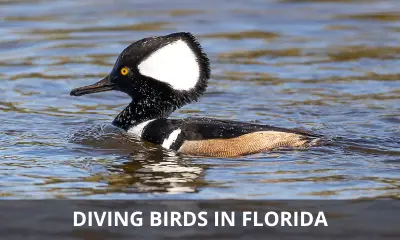
What types of diving birds are found in Florida?
There are 19 types of diving birds commonly found in Florida, which are described in full detail below.
Ring-necked Duck
Scientific name: Aythya collaris
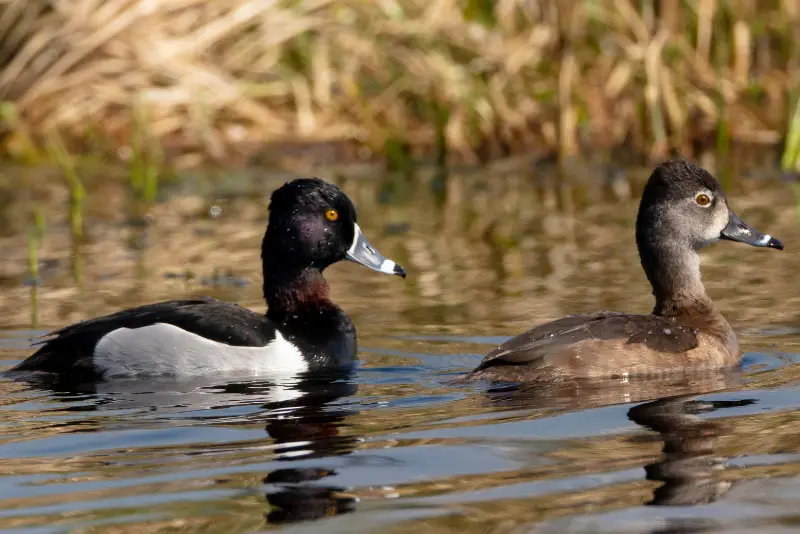
These ducks breed in northern North America, but occur as winter visitors throughout the state of Florida.
Male Ring-necked Ducks have a combination of black, white, and gray plumage, as well as a bright yellow eye and a white ring around the bill.
While these ducks dive for food, their preference is for shallow ponds and swamps. Females are largely dark brown, and are best identified by their association with Ring-necked Duck males.
Lesser Scaup
Scientific name: Aythya affinis
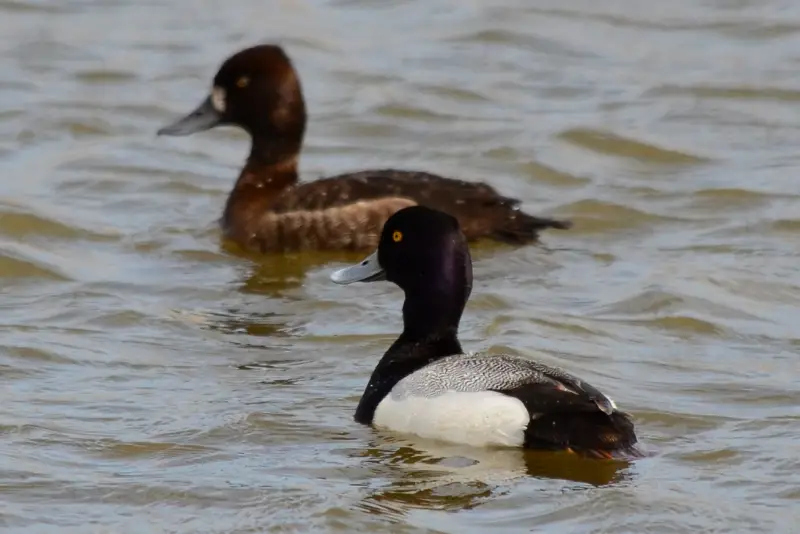
While Lesser Scaups look superficially similar to Ring-necked Ducks, they can be identified by their gray back, as well as uniformly gray bills that don’t have a white ring.
These ducks prefer large lakes, although they also occur on smaller water bodies during migration.
Lesser Scaups can be encountered wintering in all parts of the state, with a preference for large freshwater lakes and reservoirs.
Common Goldeneye
Scientific name: Aythya affinis
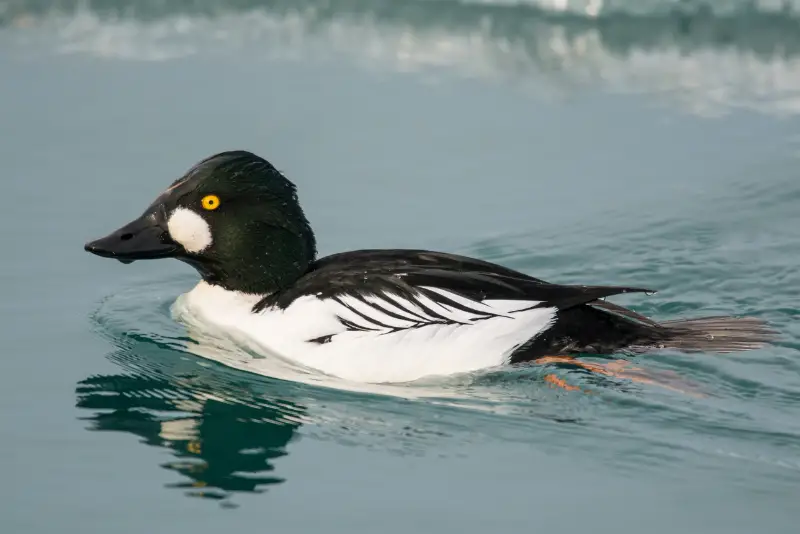
Similar to many other diving ducks, the Common Goldeneye is a breeding bird of the forests of Canada, and is seen in the lower 48 states only during winter.
Males are easy to recognize, due to their dark green head with a white patch behind the beak, as well as a pure white body and black wings.
Common Goldeneyes occur on protected saltwater bodies of water, as well as on nearby freshwater lakes.
They winter along the northern parts of the Florida Gulf Coast, as well as the northern Atlantic Coast.
Black Scoter
Scientific name: Melanitta americana

These black seaducks breed in the arctic tundra, but winter along the eastern and western seaboards of North America.
Males are uniformly black, except for a bright orange knob at the base of its beak, while females are dark brown.
Black Scoters occur along the northern Atlantic and Gulf Coasts of Florida during the winter, where they forage by diving for mussels.
Canvasback
Scientific name: Aythya valisineria
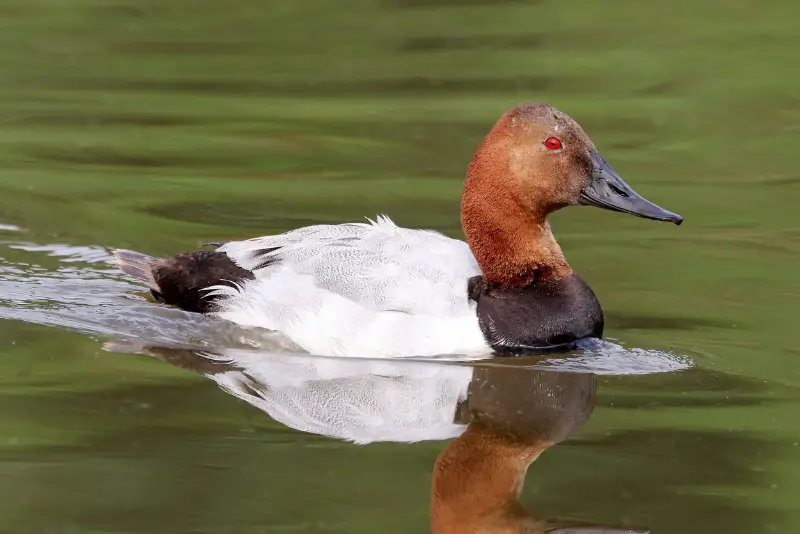
The Canvasback is a type of diving duck that feeds by eating tubers and plants from the bottom of ponds and lakes.
The male is easily recognized due to its dark chestnut head with red eyes, light gray body, black chest, and black tail.
Females look similar, but are more muted in their colors. These ducks winter in northern Florida from October to April.
Bufflehead
Scientific name: Bucephala albeola
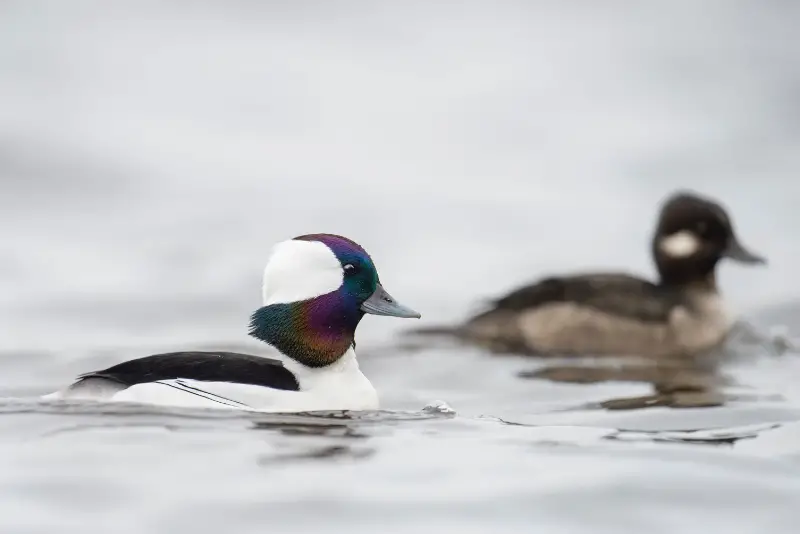
The Bufflehead is a small diving duck with a large head. Adult males are easily recognizable due to their striking black-and-white plumage.
On its head, the dark feathers also have a glossy purple and green sheen, though you need to be close in order to see this.
Buffleheads are breeding birds of Canada and the Pacific Northwest, but can be encountered wintering in northern Florida from October through April.
Pied-billed Grebe
Scientific name: Podilymbus podiceps
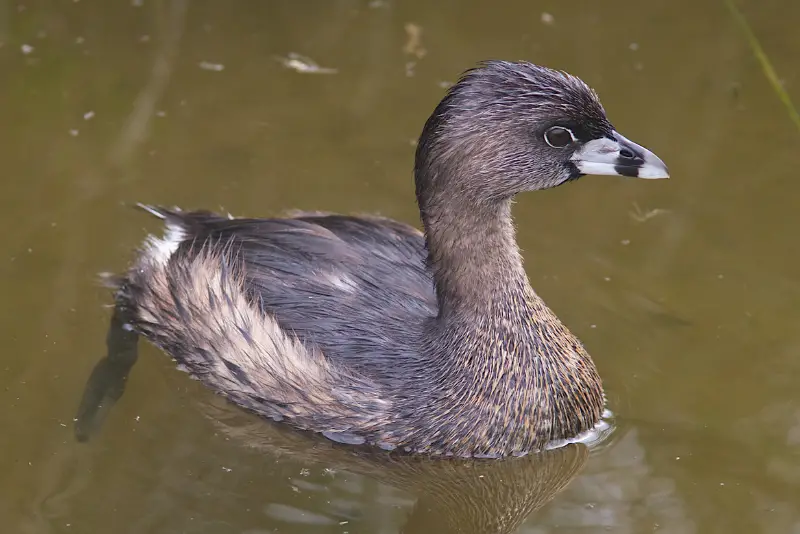
This small diving bird is easily overlooked, due to its diminutive size and inconspicuous brown coloration.
Pied-billed Grebes are expert divers that hunt fish and other small underwater animals, including small crayfish and insect larvae.
These small Florida waterbirds are widespread and common throughout the state, where they can be encountered year-round on lakes and ponds with generous vegetation.
Hooded Merganser
Scientific name: Lophodytes cucullatus
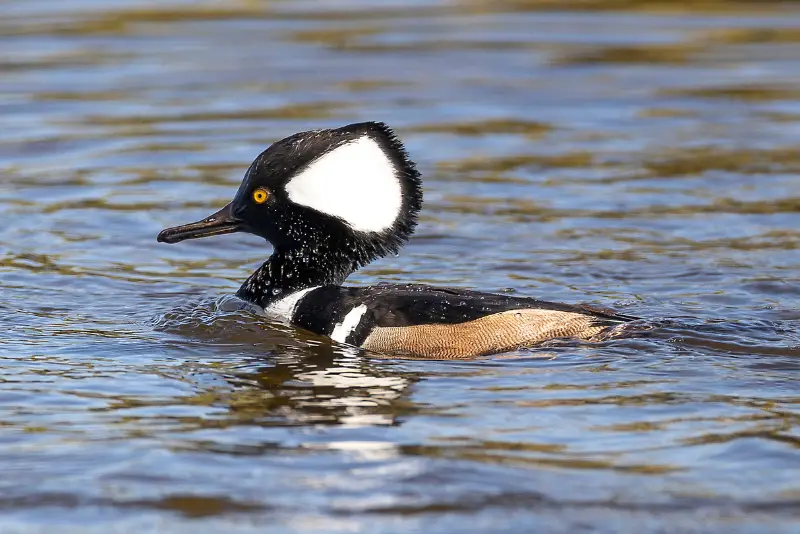
The Hooded Merganser is a small merganser with a large head. It breeds throughout the eastern United States, as well as the Pacific Northwest.
Males can be recognized by their black and white crest, as well as a black and white body with chestnut brown flanks.
Hooded Mergansers are common winter birds in Florida, where they can be encountered on small lakes, saltwater bays, and estuaries. They forage by diving for small fish and aquatic invertebrates.
Common Loon
Scientific name: Gavia immer
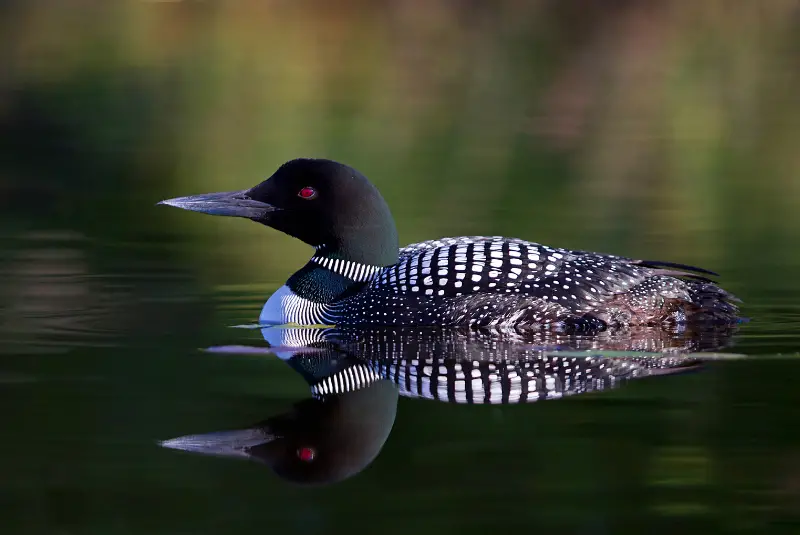
If you spotted a black waterbird with white dots, it is most likely the Common Loon (also known as the Great Northern Diver).
These large water birds breed in northern areas of North America and can be seen along the coastline of Florida during the winter.
The common loon is a fantastic diver and is super stealthy when it hunts underwater, allowing it to sneak up on fish without even a splash. It can dive to depths of up to two-hundred fifty feet.
To top that off, these birds can stay submerged for up to five minutes and even swallow their prey while they are still underwater.
American Coot
Scientific name: Fulica americana
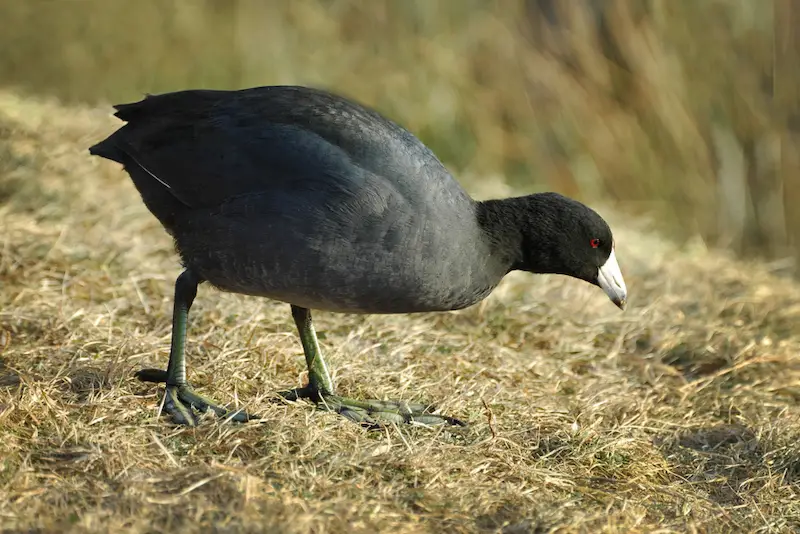
American Coots are regularly observed congregating in huge flocks on open water (especially during migration).
While American Coots are water birds, they don’t have webbed feet like ducks, but instead have broad, lobed toes.
In addition to their ability to swim on top of the water, Coots are also strong divers, and often forage for food on the bottom of shallow lakes and ponds.
American Bald Eagles like to prey on Coots, and will try to tire out an individual by repeatedly forcing it to dive until it is too exhausted and gives up.
These black Florida birds may be found in a variety of aquatic habitats, including urban park ponds, reservoirs, marshes, and lake shores.
Double-crested Cormorant
Scientific name: Phalacrocorax auritus
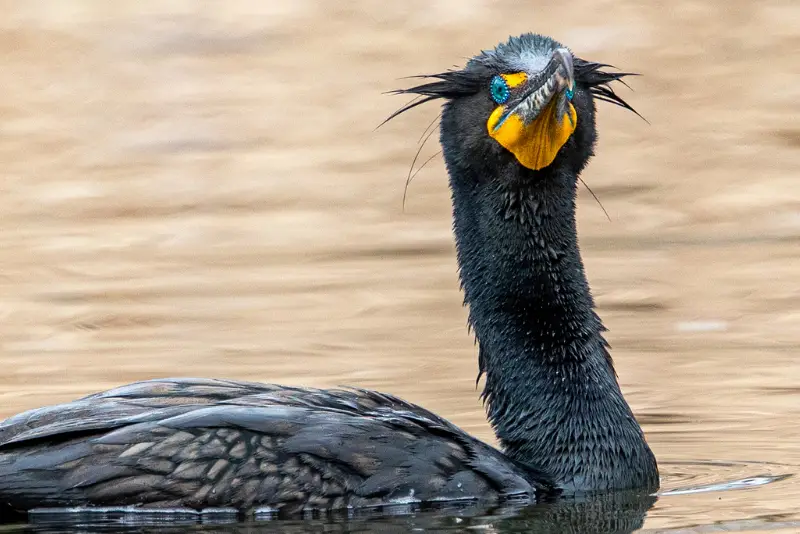
The Double-crested Cormorant is a large, dark waterbird with a long neck and blue eyes. It is a year-round resident in Florida, and is commonly found on coastal waters.
This cormorant likes to gather in large flocks that roost on trees close to water. It is a skilled diver and hunts fish with its large, black bill.
When a group of cormorants flies together, they like to form up in V shaped formations, which can be seen in the evening, when the birds fly to their roosting spots in Florida.
Anhinga
Scientific name: Anhinga anhinga
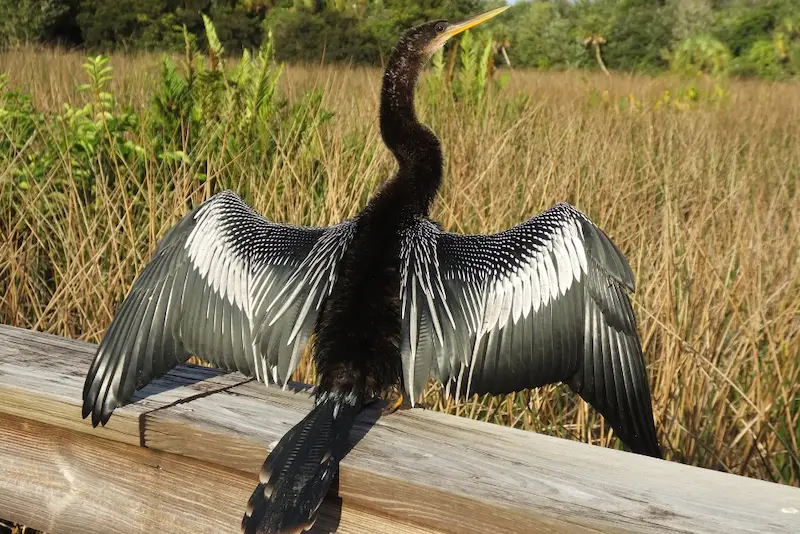
The Anhinga looks similar to a cormorant, but has a snake-like neck, which it uses to catch fish underwater.
When it is in the water, it swims with its body submerged, and it’s common to see only the head and neck protruding above the water surface, making it look like a snake bird.
Adult male Anhingas are almost entirely black, while females have a dark brown head and neck, as well as black body plumage.
This bird lives in swamps and freshwater ponds, and is a year-round resident in Florida.
Brown Pelican
Scientific name: Pelecanus occidentalis

Brown Pelicans are the most common pelicans found in Florida, where they dive for fish by plunging head-first into the water.
Adult Brown Pelicans are grayish brown with a dark belly, and can be easily recognized by their massive bill.
While this pelican species was endangered a few decades ago due to pesticide poisoning, it has now recovered and is once more a common breeding bird and year-round resident in the state.
American White Pelican
Scientific name: Pelecanus erythrorhynchos
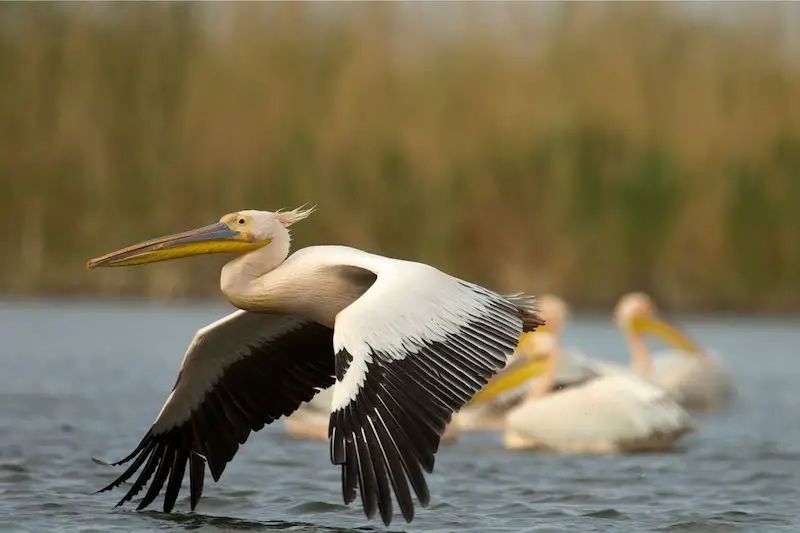
The American White Pelican is the biggest bird in Florida, and is a lot bigger than the Bald Eagle.
American White Pelicans are only observed in Florida during the winter months, as they make Florida their home during the cold season.
Its preferred habitat in Florida are estuaries, shallow bays, and coastal inlets, as well as freshwater lakes further inland.
This bird feeds almost exclusively on fish, but unlike other pelican species it doesn’t dive in order to catch them. Instead it submerges its head down into the water, and grabs fish with its big beak.
Northern Gannet
Scientific name: Morus bassanus
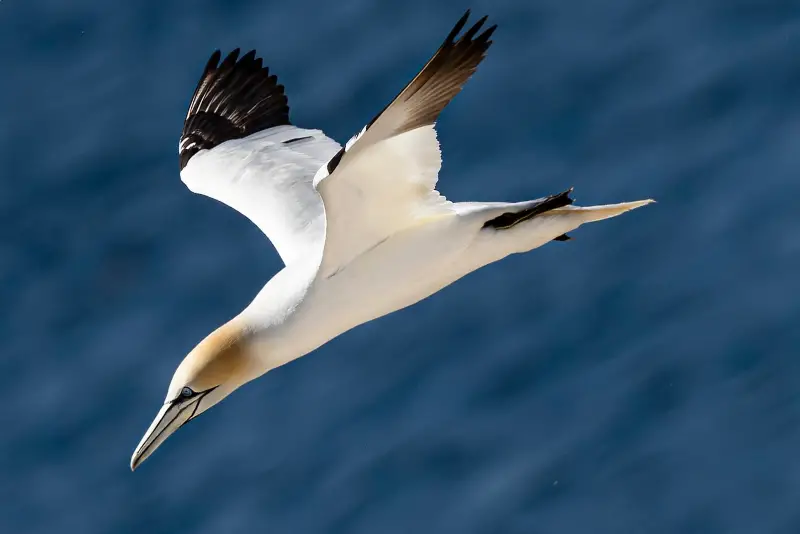
These birds are impressively large and are nearly as big as albatrosses. They have extremely sharp beaks that are designed to tear through fish, which is their primary food.
Adult northern gannets have pointed tails with long and slender wings. They are predominantly white with black wingtips and a golden crown.
If you see these birds, notice how fast they dive in order to catch their food, and plunge into the water only to resurface with a mouth full of fish.
Northern Gannets nest on the cliffs of northern North America, but are regularly encountered wintering along the entire coast of Florida.
Forster’s Tern
Scientific name: Sterna forsteri

The Forster’s Tern is a medium sized tern that is a common breeding bird along the shores of Florida.
Adult birds are almost entirely white, except for their gray mantle and black cap. Their orange beak has a black tip.
In its non-breeding plumage, it loses most of its black cap, but can be identified by a characteristic comma shaped black eye patch.
These birds dive into the water to catch small fish, and often disappear entirely into the water before reappearing a few seconds later.
Caspian Tern
Scientific name: Hydroprogne caspia
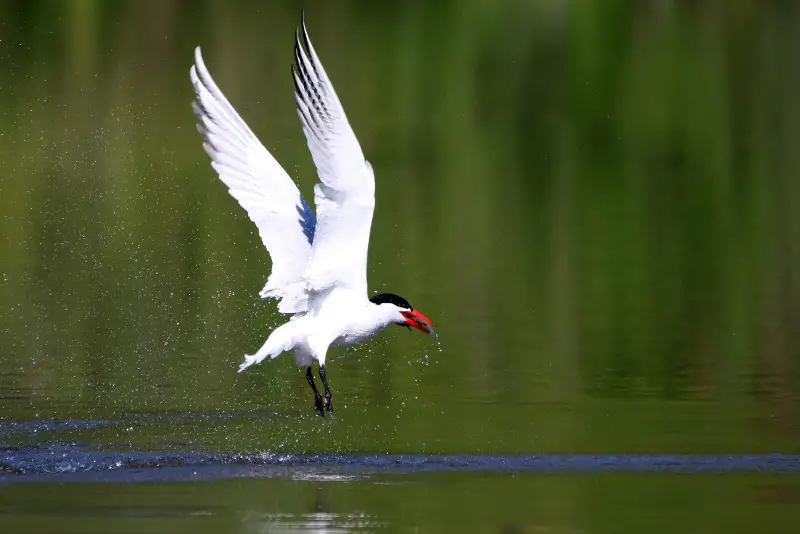
The Caspian tern is the largest tern species in the world, and a rare winter visitor in Florida.
It superficially resembles the Forster’s Tern, but it is a much larger bird and has a thicker bill, broader wings, and a less forked tail.
The Caspian Tern is not only a skilled hunter that catches fish by diving into the water with astonishing precision, but also steals food from other terns and gulls.
The Caspian Tern breeds in freshwater habitats in Canada and northern USA, and winters in the Caribbean and the Gulf of Mexico.
Belted Kingfisher
Scientific name: Megaceryle alcyon

Adult Belted Kingfishers are almost entirely teal blue on top, except for a white collar that separates the cap from the rest of the body.
The Belted Kingfisher prefers habitats directly adjacent to lakes and rivers, where it hunts for fish in shallow lakes and streams by diving headfirst into the water to catch them.
This water bird species is a partial migratory bird, but can be seen year round in southern parts of its range, including Florida.
Osprey
Scientific name: Pandion haliaetus

The Osprey has a wingspan of up to 69 in (5.5 ft), and resembles an eagle in size.
Ospreys are easy to identify, due to their white underparts and blackish gray upperparts, as well as black wrist patches on their lower wings.
This large bird of prey is the only raptor that dives into water to catch fish, often becoming entirely submerged in the water as it attempts to grab a fish with its feet.
Due to this style of hunting, Ospreys are almost always found close to water, except during migration, when they will cross areas without water.
The Osprey is a regular though not very common breeding bird throughout the state of Florida.
Final remarks
In summary, here are the 19 different types of diving birds found in Florida:
- Ring-necked Duck
- Lesser Scaup
- Common Goldeneye
- Black Scoter
- Canvasback
- Bufflehead
- Pied-billed Grebe
- Hooded Merganser
- Common Loon
- American Coot
- Double-crested Cormorant
- Anhinga
- Brown Pelican
- American White Pelican
- Northern Gannet
- Forster’s Tern
- Caspian Tern
- Belted Kingfisher
- Osprey
If you’ve spotted one of these while bird watching in Florida, but aren’t sure which species of bird it was, check our detailed bird identification guide above with photos.
If you enjoyed this article, check out our guide to the Florida birds with long beaks.
